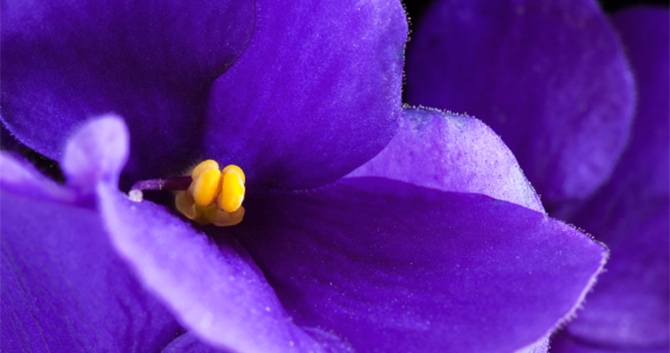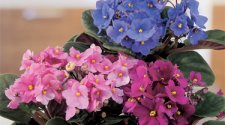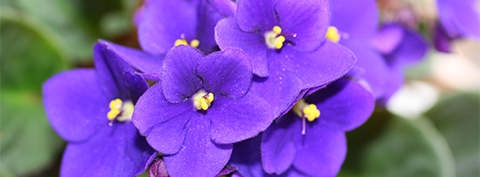 African Violets are not actually related to any violet species!
African Violets are not actually related to any violet species!
African Violets are the world’s most popular houseplants, and for good reason! Rich, velvety colors and continuous blooms make African Violets truly unforgettable. Find out how to make the most of yours!
People may initially put off trying an African Violet because of they’ve heard stories about high-maintenance prima donnas. Well, here’s some news for those missing out: African Violets are actually surprisingly easy to take care of! Even for the casual gardener, African Violets are a delight to grow and will keep your home looking fresh and bright year-round.
History
African Violets are not actually related to any violet species; they simply resemble violets in shape and color. Their actual name is Saintpaulia ionantha, honoring Baron Walter von Saint Paul-Illiare, a German district commissioner who discovered them on a visit to Eastern Tanzania in 1892. He sent specimens of the strikingly beautiful plants to his father, an amateur botanist. Eventually African Violets were delivered to the German Royal Botanical Garden, where they were given their eponymous Latin name.
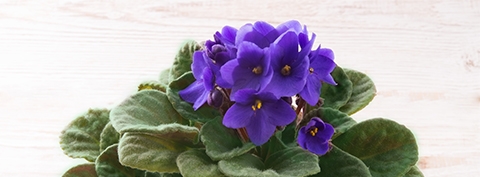 African Violets prefer indirect light and moderate temperatures
African Violets prefer indirect light and moderate temperatures
The African Violet’s popularity spread quickly across the globe – with one notable exception. The drafty, dark winter conditions in New England homes caused African Violets to wilt and languish. It took the invention of the light bulb and modern home heating for African Violets to thrive indoors in cold-winter climates.
Plant Selection
African Violets are available in a variety of charming shades and patterns, with blues and purples being the most popular. They come in varying bloom sizes and shapes, giving you the ultimate freedom in decorating your home!
When purchasing African violets, look beyond the gorgeous flowers and choose plants that have a single crown. Also check that the leaves are deep green, spot-free and growing symmetrically around the center.
Basic Care
African Violets make fantastic indoor plants, and grow well in the same in-home conditions that are comfortable to most people. While individual violets differ in the duration of their flowering period, some will bloom continuously, and most will re-bloom at least every six months with proper care. By growing several plants, it’s even easier to keep some African Violets blooming continuously in your home.
Just follow these simple tips for making the most of your African Violets:
Temperature: African Violets prefer warmer temperatures, which is why they grow well indoors. During the day, try to keep them at about 70 degrees Fahrenheit, allowing them to get down to the 60’s at night. Don’t let the temperature fall below 60 degrees Fahrenheit too often, as the cold can stunt growth.
Light: African Violets prefer indirect sunlight. They will do well in a spot a few feet from a window, or in any brightly lit room, even under artificial lighting. Avoid exposing them to direct sunlight, which can damage their leaves.
Water: Water your African Violets thoroughly, and then allow the soil to become dry to the touch between watering. The biggest mistakes many make are using cold water on their African Violets and wetting the leaf surface – which can cause poor blooms and leaf-spot. A long-spouted watering can makes it easy to slip the spout under the leaves, and make sure to use room-temperature water to keep your African Violet healthy and beautiful!
Humidity: Try to keep your home at a comfortable level for you, and don’t let your plants get too dry. If you live in a particularly dry region, try adding a humidifier to the room where you keep your African Violet. Another trick to ensure a good level of humidity is to set the on a pebble tray (see Sidebar).
Fertilizer: Specially formulated African Violet fertilizer is available at most garden centers. Choose a product that boasts a wide range of essential nutrients. African Violets are very sensitive to over-fertilization, so less is more in this case. Follow package instructions for mixing and recommended application rates.
After your African Violet has stopped blooming, trim off the spent blooms and flower stems and cut back any dead leaves you see. Continue to give the plant proper care and it should start to bloom again fairly soon.
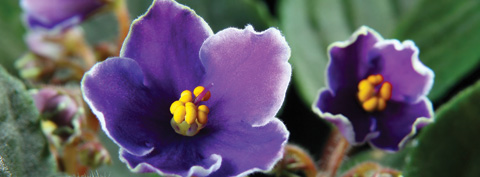 Buy several African Violets to have year-round blooms!
Buy several African Violets to have year-round blooms!
Repotting
Plants grow and flower best when they are snug in their pots, so repot only when they start to get crowded. You’ll know it’s time when your plants start to form multiple crowns and lose lower leaves.
For best results when repotting, choose a container that is about 1 inch wider than the old one. African Violets can be easily grown in clay or plastic pots. While material doesn’t matter so much, adequate drainage is highly important – make sure your pot has holes or a draining system.
For best results, grow African Violets in a quality potting mixture that is high in organic matter. Most garden centers sell specialized “soilless” mixes labeled for African Violets and similar plants, which provide just the right conditions to encourage growth.
Planting Outside
African Violets are native to the humid, consistently warm landscape of Tanzania. Any substantial fluctuations in temperature can damage an African Violet, and frost or consistent cold weather will certainly kill it. African Violets do much better as indoor plants in the United States, as they thrive in comfortable room temperatures.
Trouble Shooting
If your African Violet is not blooming well, insufficient light can be a contributing cause. Consider moving your plant closer to a window or putting it in a better-lit room. Make sure to prune dead or damaged leaves consistently to avoid disease.
Too much water is also a common problem with African Violets. If you notice yellowing or white patterns on the leaves, the water you are using is too cold, it is getting on the leaf surface, or you have been over-watering the plant!

